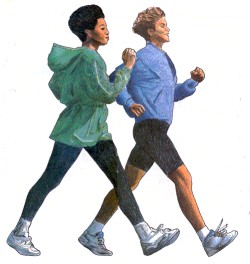A stiff legged deadlift is a great stretch to make sure that you are always improving your flexibility. Not only initially will you be able to tell how well you are doing, but as you improve your flexibility you will have better body control and your movement will be much better.
First remember if you are going to stretch you need to be very careful to only stretch after having warmed up. Stretching while you are cold can lead to muscle pulls.
Have a short 5 minute warmup of cardio so that you are sweating just a bit and your muscles are loose and warm and then do your stretches.
Doing A Stiff Legged Deadlift
Position: A standing position with the feet a comfortable distance apart, the knees locked and the barbell held in front of the legs with the elbows straight.

Action: Keeping both knees and elbows straight, the trunk is bent forward as far as is comfortable, then the erect position is regained.
Breathing: Exhale as the body is bent forward and inhale as the erect position is regained.
Starting Resistance: Most women will find a starting resistance of 25 lbs. quite comfortable and most men 40 lbs.
Goal: Girls and women should work up to a resistance of 50 lbs. Boys and men should work up to a resistance of 100 lbs. or more.
Results: This movement will develop and strengthen the large muscles of the lower back and will also strengthen those of the hips and back of the thighs. It is very necessary that these muscles be well developed and strong. They protect the spine and sacro-iliac joints from injury and their strength gives a margin of safety against low back pain and discomfort.
Comments: As the back is bent forward, the muscles in the back and the back of the legs are stretched extensively.
Because of differences in anatomical construction and flexibility, some children and adults will be able to bend forward and touch the floor easily, while others will not be able to bend much more than half the way down. The exerciser should not bend any further forward than is comfortable, but with practice the back will become more flexible and very strong.
In the fully stretched position with the knees locked and the hands close to the floor, much pressure is placed upon the inner borders of the intervertebral discs. The untrained individual invites low back trouble by lifting heavy objects in this position. The proper position to use in lifting heavy objects from the floor is to make the effort with the knees bent and the back relatively flat so that much of the effort is taken by the legs and the back is kept in relatively good position.
In advanced training of athletes who need great strength in the lower back, this movement is used through a short range of movement with very heavy resistance. The movement is started from a standing position and the bar is lowered to about the height of the knees.
During the motion the lower back is kept flat and fixed (never permitted to “round”) and the motion is made almost entirely from the hips. In this position the lumbar spine is kept in a strong position with little pressure on the front borders of the vertebrae. The bar is usually lowered to a predetermined height regulated by some support set at that position for the bar or weights to touch.



